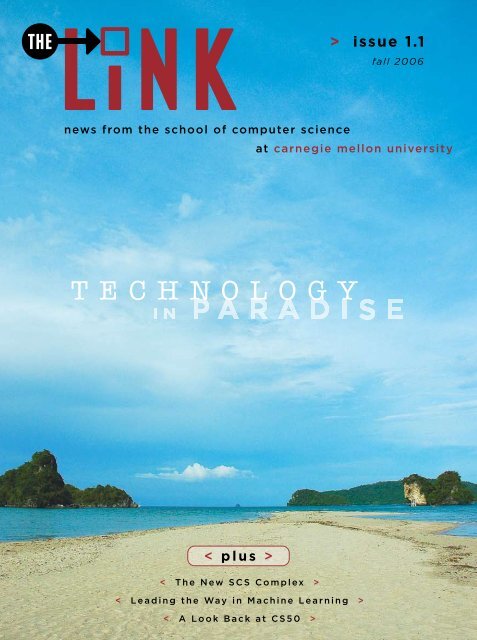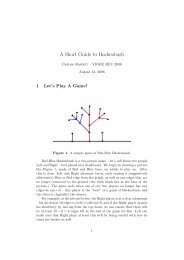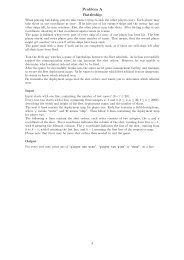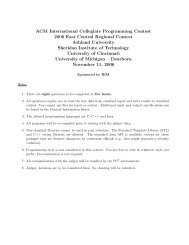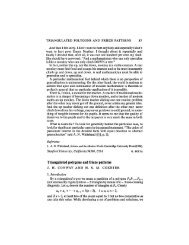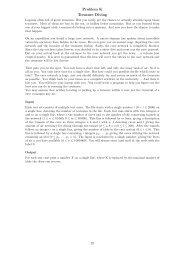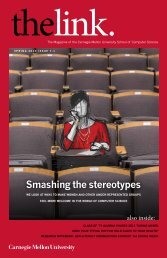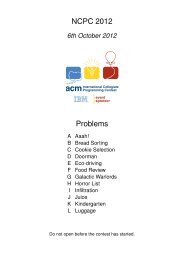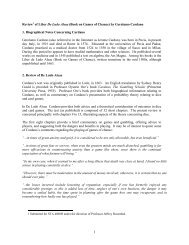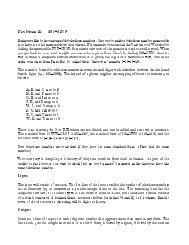Begin Download (3.7 MB) - Link home page - Carnegie Mellon ...
Begin Download (3.7 MB) - Link home page - Carnegie Mellon ...
Begin Download (3.7 MB) - Link home page - Carnegie Mellon ...
- No tags were found...
You also want an ePaper? Increase the reach of your titles
YUMPU automatically turns print PDFs into web optimized ePapers that Google loves.
news from the school of computer scienceat carnegie mellon university< p l u s >< T h e N e w S C S C o m p l ex >< L e a d i n g t h e Wa y i n M a c h i n e L e a r n i n g >< A L o o k B a c k a t C S 5 0 >
Calendar of Events< 2006 >< 2007 >news from the school ofcomputer science atcarnegie mellon universityThe <strong>Link</strong> provides a mosaic of the School ofComputer Science: presenting issues, analyzingproblems, offering occasional answers, givingexposure to faculty, students, researchers, staff andinterdisciplinary partners. The <strong>Link</strong> strives toencourage better understanding of, and involvementin, the computer science community.Editor-in-ChiefRandal E. BryantManaging Editor/WriterJoanna StewardContributing WritersTina Carr, Byron Spice, Anne WatzmanPhotographyKen Andreyo, David Bachman, Glenn Brooks, StanFranzos, Joe Mertz, Mary Shaw, 2006 TCinGC studentsDesignFitting GroupPrinted byKnepper Presson 10% post-consumer recycled paperOffice of the Dean4305 Newell-Simon Hall<strong>Carnegie</strong> <strong>Mellon</strong> University5000 Forbes AvenuePittsburgh PA 15213Randal E. Bryant, deanTina Carr, director of alumni relationsCindy Chemsak, administrative assistantByron Spice, co-director of public relationsJoanna Steward, publications writer/editorAnne Watzman, director of public relations412-268-7884The<strong>Link</strong>@cs.cmu.edu<strong>Carnegie</strong> <strong>Mellon</strong> University does not discriminate and <strong>Carnegie</strong> <strong>Mellon</strong>University is required not to discriminate in admission, employment, oradministration of its programs or activities on the basis of race, color, nationalorigin, sex or handicap in violation of Title VI of the Civil Rights Act of 1964,Title IX of the Educational Amendments of 1972 and Section 504 of theRehabilitation Act of 1973 or other federal, state, or local laws or executive orders.In addition, <strong>Carnegie</strong> <strong>Mellon</strong> University does not discriminate in admission,employment or administration of its programs on the basis ofreligion, creed, ancestry, belief, age, veteran status, sexual orientation orin violation of federal, state, or local laws or executive orders. However,in the judgment of the <strong>Carnegie</strong> <strong>Mellon</strong> Human Relations Commission,the Presidential Executive Order directing the Department of Defenseto follow a policy of “Don’t ask, don’t tell, don’t pursue” excludesopenly gay, lesbian and bisexual students from receiving ROTC scholarshipsor serving in the military. Nevertheless, all ROTC classes at<strong>Carnegie</strong> <strong>Mellon</strong> University are available to all students.Inquiries concerning application of these statements should bedirected to the Provost or the Vice President for Enrollment, <strong>Carnegie</strong><strong>Mellon</strong> University, 5000 Forbes Avenue, Pittsburgh, PA 15213, telephone412-268-2000.<strong>Carnegie</strong> <strong>Mellon</strong> University publishes an annual campus security reportdescribing the university’s security, alcohol and drug, and sexual assaultpolicies and containing statistics about the number and type ofcrimes committed on the campus during the preceding three years.You can obtain a copy by contacting the <strong>Carnegie</strong> <strong>Mellon</strong> Police Departmentat 412-268-2323. The security report is available through the WorldWide Web at www.cmu.edu/police/statistics.htm.All rights reserved. No part of this publication may be reproducedin any form without written permission from the Office of the Dean,School of Computer Science.October 12-15HomecomingDon’t miss these SCS activities:Friday: Attend a hands-on Alice workshop, sit in onan open class in Robotic Manipulation (George Kantor,SCS project scientist) or Principles of Computation(Tom Cortina, SCS lecturer) and hear SCS ProfessorBernardine Dias on a panel about “Educating theChangemakers.”Saturday: SCS Professor Peter Lee and others discuss“Preserving America’s Competitive Edge” and learnabout “Transforming Lives Through InnovativeTechnology” with SCS Professor Jim Osborn.October 17SCS Alumni Networking Reception> Washington, D.C.October 19<strong>Carnegie</strong> <strong>Mellon</strong> Network NightNew York> Google HeadquartersOctober 21SCS Alumni Networking ReceptionHost Chris Maeda (CS’92, ’97)> BostonOctober 23“Wall Street” Networking NightAn informal networking event for <strong>Carnegie</strong> <strong>Mellon</strong>alumni professionals currently working in investmentbanking, research sales and trading, asset management,private banking, corporate finance and hedge funds.Sponsored by the Tepper School of Business.> New York CityDecember 4Dan 60: Four Decades of InnovationAn event to honor Dan Siewiorek on his 60th birthday.> University Center,<strong>Carnegie</strong> <strong>Mellon</strong> campusDecember 6Building Virtual WorldsStage presentation of the best interactive virtualworlds created by interdisciplinary teams this fall atthe Entertainment Technology Center.> University Center,<strong>Carnegie</strong> <strong>Mellon</strong> campusJanuary 9<strong>Carnegie</strong> <strong>Mellon</strong> Network NightSan Francisco> San Francisco War Memorial& Performing Arts CenterJanuary 10<strong>Carnegie</strong> <strong>Mellon</strong> Network NightSilicon Valley> The GoogleplexJanuary 11<strong>Carnegie</strong> <strong>Mellon</strong> Network NightLos Angeles> Japanese AmericanNational Museum<strong>Carnegie</strong> <strong>Mellon</strong> Network NightSeattle> Location TBAFebruary 2<strong>Carnegie</strong> <strong>Mellon</strong> Network NightPittsburgh> PNC ParkMarch 8<strong>Carnegie</strong> <strong>Mellon</strong> Network NightWashington, D.C.> Cannon House Office BuildingMarch 8-9TK60: Celebrating Kanade’s VisionA symposium honoring Takeo Kanade on his60th birthday.> University Center,<strong>Carnegie</strong> <strong>Mellon</strong> campusMarch 14<strong>Carnegie</strong> <strong>Mellon</strong> Network NightBoston> Location TBAMarch 15<strong>Carnegie</strong> <strong>Mellon</strong> Network NightChicago> Symphony CenterVisit www.alumni.cmu.edu and click on Upcoming Events for details.Correction: In the 50 Years of Computer Science at <strong>Carnegie</strong> <strong>Mellon</strong> timeline in thefirst issue of The <strong>Link</strong>, the 1984 work on MIME protocol was incorrect. The entryshould have read as follows: The Andrew Messaging System creates the first multimediaemail community and ultimately leads to the MIME standard (Borenstein,Everhart, Rosenberg). We apologize for the error.
Contents2 From the Dean12 Technology in ParadiseA unique program called TCinGC takes talented<strong>Carnegie</strong> <strong>Mellon</strong> students around the world andacross the digital divide.9 A Taste ofTechnologyTransferGetting new innovationsout of the lab and intothe world.16 CS50 RecapFour days of photos injust four <strong>page</strong>s.3 Machine LearningDepartment<strong>Carnegie</strong> <strong>Mellon</strong> takes thelead with the first academicdepartment of its kind4 The New SCS Complex6 In the LoopMeet two members of ourdistinguished faculty7 Student Awards8 2006 Robot Hallof Fame InductionsFive new robots are inductedinto the Robot Hall of Fame20 SCS Alumni RelationsHear from the director andlearn about alumni gatherings22 Alumni SnapshotsMeet five alumni that span theSCS semi-centennial24 SCS in the News
From the DeanWelcome to our secondissue of The <strong>Link</strong>. We hopeyou enjoy reading about some ofthe innovative programs and peoplethat make up the vibrant School ofComputer Science (SCS) community.Last April we had an excitingcelebration on campus—CS50: FiftyYears of Computer Science at <strong>Carnegie</strong><strong>Mellon</strong>. It was a remarkable success thatbrought together some of our earliestpioneers, myriad alumni and the currentbody of SCS students, faculty and staff.Turn to <strong>page</strong> 16 for a look back at the four days of activities and symposia. Eventhough I’ve been part of the CS community at <strong>Carnegie</strong> <strong>Mellon</strong> for 22 years, thisevent opened my eyes to the deep insights of our founders and the great impact thatour efforts have had on many individuals and on society overall.Many of the new technologies that continue to shape the world around us comefrom university research programs across the country. New efforts by <strong>Carnegie</strong><strong>Mellon</strong> are helping to transfer more SCS technologies to independent companiesand open-source ventures each year. A “Taste of Technology Transfer” on <strong>page</strong> ninegives us a glimpse into some of the recent SCS successes.Our cover story, “Technology in Paradise,” highlights a unique program that iscontributing to modern society by making a difference in communities on bothsides of the digital divide. This international opportunity is available to all<strong>Carnegie</strong> <strong>Mellon</strong> students through TechBridgeWorld, a university-wide initiativebased in SCS.Closer to <strong>home</strong>, the construction of the new SCS complex is having a greatimpact on the <strong>Carnegie</strong> <strong>Mellon</strong> campus. These new buildings, the largest ofwhich will be the Gates Center for Computer Science, is one of the biggestconstruction projects on campus in over a decade. You can learn more about thisimpressive transformation by turning to <strong>page</strong> four, by visiting our building blogat http://gatescenter.blog.cs.cmu.edu/overview or by visiting campus and seeing itfor yourself.> Randal E. Bryant, dean2 > THE LINK
Machine Learning DepartmentLeading the WayFollowing in the footsteps of the visionaries who created theComputer Science Department back in 1965, <strong>Carnegie</strong> <strong>Mellon</strong> andthe School of Computer Science (SCS) are once again leading theway in academics by creating the nation’s first Machine LearningDepartment (MLD).“Machine learning has grown and flourished at<strong>Carnegie</strong> <strong>Mellon</strong>, drawing ideas from and contributingto many parts of the university. It has evolved into anarea of sufficient breadth and depth to merit recognitionas a distinct academic discipline,” says SCS Dean RandalBryant. The new MLD will replace the existing Centerfor Automated Learning and Discovery (CALD) within SCS. Thechange reflects not only the importance of machine learning in thetechnology of the 21st century, but also a strong commitment bythe university to continue its pioneering work in the field.MLD’s first department head will be Tom Mitchell, the Fredkinprofessor of artificial intelligence and learning. Mitchell co-foundedCALD in 1997 and was instrumental in developing the currentmachine learning coursework, including the country’s first Ph.D. inmachine learning. The new department also boasts seven facultymembers who are on the editorial boards of the field’s top journals.Over the past 50 years the study of machine learning has grownfrom a handful of computer scientists exploring whether or notcomputers could learn to play games and a separate group of statisticianswho largely ignored computational considerations into a broaddiscipline that has produced fundamental statistical-computationaltheories of learning processes, has designed learning algorithms thatare routinely used in commercial systems for speech recognition,computer vision and a variety of other tasks, and has spun off anindustry in data mining to discover hidden regularities in the growingvolumes of online data. “Even 20 years ago, machine learninghad few commercial applications,” Mitchell says, “but now it is themethod of choice for an important niche of software applicationsthat will grow rapidly as we develop more accurate learning algorithms.”Today, machine learning enables data mining techniquesthat are used by grocery chains to analyze the purchasing habits oftheir customers and by astrophysicists to recognize new cosmicphenomena within sky survey data. The U.S. Postal Serviceemploys computer-vision-trained machine learning on a massivescale to automatically sort 85 percent of the snail mail letterscontaining handwritten addresses. Their handwriting analysissoftware is trained to very high accuracy using machine learningover a very large data set.Machine learning methods are also reshaping the practices ofmany data-intensive empirical sciences, like biology and physics,and many of these sciences now hold workshops on machine learningas part of their field’s conferences. Likewise, the 23rd InternationalConference on Machine Learning, held this pastJune on the <strong>Carnegie</strong> <strong>Mellon</strong> campus, includedinterdisciplinary workshops such as “Learning inStructured Output Spaces” and accepted paperson topics ranging from medical image classificationto cost-sensitive learning and from statisticaldebugging to Bayesian pattern ranking in theancient game of Go.“Machine learning has emerged as a distinctscientific discipline and one that is uniquelysuited to <strong>Carnegie</strong> <strong>Mellon</strong>’s strengths,” says<strong>Carnegie</strong> <strong>Mellon</strong> Provost and Senior VicePresident Mark Kamlet. “Drawing onboth computer science and statistics,machine learning is another example ofhow the university’s tradition of multidisciplinaryresearch produces importantscientific insights.” ∆< LOG ON >www.ml.cs.cmu.eduwww.icml2006.orgTom Mitchell,Machine Learning Department head and theFredkin professor of artificial intelligence and learningTHE LINK
These interior renderings for the new SCS complex show the broad use of natural light.one of the 315 offices will have a windowwith natural light and there will be manyopen collaborative neighborhood spaces,”says Blelloch. Other amenities include a250-seat auditorium, 13 classrooms, 11conference rooms and 8,000 square feet ofopen project space.The larger of the two buildings, theGates Center for Computer Science, wasmade possible by a lead gift of $20 millonfrom the Bill and Melinda Gates Foundation.The upper stories of the modern buildingwill be twisted slightly so that rather thanfacing the plain brick back wall of thePurnell Center, the eastern windows willface the Cut and the southern windows willlook out over the new green space towardsDoherty Hall. Views of Oakland and theCathedral of Learning will dominate thewestern windows.The smaller trapezoid-shaped building,as yet unnamed, will be dedicated toresearch and will create a welcoming spaceon Forbes Avenue. Its green roof will be thesecond-largest of the five green roofsplanned throughout the complex. Thelargest will cover a 150-space undergroundparking garage with a wide expanse of grassand be edged by Northern Bayberry shrubsand Quaking Aspens.The SCS Complex will forge newconnections across campus as well. A fullyaccessible pedestrian bridge will extend eastfrom the fifth level of the Gates Center tothe Cut. One floor down, another bridgewill connect the Gates Center with the topfloor of Newell-Simon Hall.The buildings are scheduled to open inearly 2009. ∆< LOG ON >http://gatescenter.blog.cs.cmu.eduhttp://gs3020.sp.cs.cmu.edu/~webcam“Our goal is for this new buildingto be a catalyst for computerscience breakthroughs. <strong>Carnegie</strong><strong>Mellon</strong> is one of the top schoolsfor computer science in thenation, and we hope thefoundation’s gift will help theschool continue to excel andpush the envelope of humanunderstanding and innovation.”> Bill Gates,co-founder of the Bill &Melinda Gates FoundationThe Gates Center for Computer Science as it will look from the new West Quad between Newell-Simon and Smith halls.THE LINK
In the Loop with SCS FacultyJeannette WingPresident’s Professor of Computer ScienceHead, Computer Science DepartmentComputational Thinking:“Deep technical challenges remain inthe field of computer science and weneed to do something to engage the nextgeneration of researchers. Promoting computationalthinking across all disciplinesand to younger students will convey thebreadth and depth of our field and showthem that there is more to computerscience than just programming.“As computer scientists, we think atmany layers of abstraction, using variousalgorithmic and assertional approaches toresearch problems. But if we look around,many abstract computer science conceptscan be found in our daily lives. For instance,when your daughter goes to school in themorning, she fills her backpack with thethings she’ll probably need that day.That’s prefetching and caching. Choosingwhich line to stand in at the supermarketcheckout is job scheduling. Computationalthinking can be used as a ‘bumper sticker’for the computer science community.“The response to my article on computationalthinking in Communications ofthe ACM has been fantastic so far. I’veheard positive comments fromhardcore academics to current industryleaders and from retiredIT professionals to high schoolAP teachers.”ResearchingTrustworthyComputing:“To build bettersystems, we have tolook at not only thelongstanding computerscience concernsof security andreliability, but also atvarious privacy issuesthat until recentlyhad been left topolicy makers andlawyers. Another major system concern isusability. The human user is often theweakest link—no matter how strong yournetwork security or how reliable your software,one successful social engineering scamcan wreak havoc on an entire system. Bytaking a holistic approach, we can createsystems that are more trustworthy.”The Administrative Angle:“I love to teach and engage withour students and I am truly lookingforward to co-teaching Modelsof Software Systems this fall.However, I also appreciate my roleas department head. It gives meunique opportunities to share<strong>Carnegie</strong> <strong>Mellon</strong>’s successeswith a wide audience and tobuild awareness about theworld-class research thathappens here every day. Iam extremely proud of ourfaculty, staff and studentsand feel lucky that I getto represent them.”Daniel SiewiorekBuhl University Professor of Electrical andComputer Engineering and Computer ScienceDirector, Human-Computer InteractionInstitute (HCII)Humans, Computersand Engineers:“Engineers tend to be bottom upthinkers and computer scientists tendto be top down thinkers. Humancomputerinteraction integrates thesetwo complementary ‘tool sets’ andplaces the human user at the centerof the computing system.”Context Awareness:“We’re on the verge ofcontext-aware (CA) computing—creatingsystemsthat combine builtinsensors, artificialintelligence andmobile computingto proactively assist users. CA can help withinfrequent problem solving, like when yourcar’s dashboard check engine soon lightflashes. Instead of you having to searchthrough the entire maintenance manualfor an explanation (it’s usually caused byinferior gasoline), the car’s built-in softwarecould index the manual with the car’sGPS system, noting when and where youlast bought fuel, and then showyou only the appropriate sectionof the manual or suggesta remedy.CA applications can alsobe used to coach people ‘in thewild’ as opposed to only duringcontrolled training situations.We’re currently developinga wrist-wornunit for wheelchairusers to helpprevent repetitiveuse injuries likecarpal tunnel androtator cuff tears.”The Importance of Academics:“Now that many of the industrialin-house research labs have been phasedout, companies are looking to partner withinnovative universities to solve the hardquestions generated by real world problems.Theory is important, but so is taking realmeasurements with real systems, whichoften leads to new research questions. Anumber of very good Ph.D. thesis topicshave come out of summers I’ve spentconsulting with various companies.Teaching gives me the opportunity tohave an impact on the current curriculum,to write textbooks, to share new findings,to research cutting-edge applications. Andabout every 10 years, I get to sort of reinventmyself. With Moore’s Law, the majorparameters of computing are changing byup to a factor of 1,000 over a decade, soyou’d better be doing something differentbecause so much is possible now that wasn’tpossible before.Besides, interacting with students keepsyou young—they don’t know what can’tbe done.” > THE LINK
Student AwardsThroughout the 2005-06 academic year, many SCS students were honored for their accomplishments.< <strong>Carnegie</strong> <strong>Mellon</strong> Awards >Allen Newell Award for Excellence in Undergraduate ResearchKanat Tangwongsan (CS’06, CS doctoral candidate)Active Data Structures and Applications to Dynamicand Kinetic AlgorithmsAndrew <strong>Carnegie</strong> Society ScholarsYanka Li (CS’06)Benjamin J. McCann (CS’06, TPR’06)David I. Murray (CS’06, A’06)Gregory W. Price (CS’06)Computer Science Department Ph.D. ScholarshipTom Murphy VIIVirginia VassilevskaThis alumnus-endowed scholarship is awarded to current Ph.D.students whose innovative research has the potential to change thefield in which they are studying.Alan J. Perlis SCS Student Teaching AwardLuis von Ahn (CS’03, ’05)< External Scholarships and Fellowships >ARCS Foundation Scholarship:Achievement Rewards for College ScientistsMichael Dinitz (CS doctoral candidate)Daniel Wendlandt (CS doctoral candidate)AT&T Laboratory FellowshipMoira Burke (HCI doctoral candidate)Boeing Leadership ScholarshipJeffrey Grafton (CS’08)Stephanie Rosenthal (CS’07)Daniel Vann (CS’07)Andrew Warshaver (CS’08)Clare Boothe Luce Graduate FellowshipMichelle Goodstein (CS doctoral candidate)DSO Postgraduate ScholarshipLeonghwee Teo (CS’99, HCI doctoral candidate)Fulbright ScholarFrancisco Calderon (RI master’s candidate)Rolf Allan Luders (RI master’s candidate)Google Anita Borg Memorial ScholarshipPreethi Bhat-Srinivas (CS’06)Ariadna Font-Llitjos (CS’01, LTI doctoral candidate)IBM Ph.D. FellowshipVincent Conitzer (CS’03, ’06)NASA Graduate FellowshipMary McGlohon (ML doctoral candidate)Nick Patronik (CS’04, RI doctoral candidate)National Defense Science and EngineeringGraduate FellowshipNick Armstrong-Crews (RI doctoral candidate)Andrew Ko (HCI doctoral candidate)Matthew Wachs (CS doctoral candidate)National Institutes of Health FellowshipAlik Widge (CS’03, RI doctoral candidate)National Science Foundation FellowshipLillian Chang (RI doctoral candidate)Michael Dinitz (CS doctoral candidate)James Hays (CS doctoral candidate)Laura Hiatt (CS doctoral candidate)Amy Hurst (HCI doctoral candidate)Daniel Lee (CS doctoral candidate)Mark Palatucci (RI doctoral candidate)Deborah Sigel (RI doctoral candidate)Andrew Stein (RI doctoral candidate)Ling Xu (CS’04, RI doctoral candidate)Siebel ScholarshipAnna Goldenberg (ML doctoral candidate)Dinesh Govindaraju (CS’04, ’06)Estefania Pickens (ETC’06)Alla Safonova (CS’04, CS doctoral candidate)Sebastian Scherer (CS’04, RI doctoral candidate)THE LINK < 7
2006 Robot Hall of Fame InductionsDressed in a shimmering gold dinner jacket befitting his C3POalter ego, actor Anthony Daniels served as master of ceremoniesfor the third Robot Hall of Fame inductionceremony, held this past June at the SheratonStation Square in Pittsburgh as the finale to the3rd annual RoboBusiness conferenceand expo. Prior to the inductions,keynote speaker Daniel Wilson(CS’05), author of “How ToSurvive A Robot Uprising,”presented his humorous vision ofthe ways robots may eventuallyimpact our world.SCARA Selective Compliance Assembly Robot ArmDeveloped in 1978, SCARA’s revolutionary4-axis design enabled cost-effectiveprecision manufacturing of small electronicsand produced an astounding effecton the world’s economy. Today, thereare nearly 100,000 instances of therobot in operation worldwide. SCARA’sinventor, Hiroshi Makino, professoremeritus at Yamanashi University,traveled from Japan to accept theaward at the ceremony.AIBO Japanese for “companion”A small programmable robodog with the ability to learn, Sony’sAIBO was designed to bridge the gap between functionality andentertainment. Its enormous research potential spawned the internationallegged robosoccer league. Manuela Veloso, the SCS HerbSimon professor of computer science and advisorof the world-class <strong>Carnegie</strong> <strong>Mellon</strong> AIBOteams since 1998, praised its contribution toresearch in multirobot systems. Katsumi Muto,former president of Sony’s EntertainmentRobot company, accepted the honor.Maria Female robot iconBorn in the 1927 silent movie “Metropolis,” the robot Mariais one of the most iconic images in film history. She is also oneof only a handful of female robots in early science fiction. Thestunning and powerful laboratory scene in which the humanheroine’s face is transferred to the robot has often been repeated,but never duplicated.Anne Balsamo, professorof interactive mediaand gender studies atthe University of SouthernCalifornia and aMaria expert, acceptedthe award.Gort Intergalatic bodyguardAnother black and white classic film broughtGort to life in 1951 in “The Day the EarthStood Still.” A powerful yet peaceful forcefrom an alien ship, Gort is an eight-foot tallrobot with laser-like vision. Actor BillyGray, who portrayed the young boy Bobbyin the film, spoke of the fictionalrobot’s ability to identify theaggressor in a conflict and howGort “was the ultimate goldenrule enforcer.”David CyberchildThe final member of the Class of 2006 is from the modern film“A.I.” The mechanical David is programmed to think he is a realboy and permanently bonds with his human mother. David’s realworld champion, Sherry Turkle, professor of the socialstudies of science and technology at the MassachusettsInstitute of Technology, accepted the award andcited the characters’ emotional journeys and theirimpact on society, “Decisions about the role ofrobots in the lives of children and seniors cannotturn simply on whether children and the elderly ‘like’the robots. [Robots like David] make us ask ‘whatkind of relationships are appropriate to havewith machines?’” ∆Left to right: Hiroshi Makino and RI Director Matt Mason; Katsumi Muto and Manuela Veloso; Anne Balsamo and ETC Co-director Don Marinelli with a Maria replica; Billy Gray and Don Marinelli with a life-sized Gort replica; Sherry Turkle and Anthony Daniels. > THE LINK
companies, other laboratories and otheruniversities. It may be that moving a technologyto several other universities is asimportant as starting a company.”The overall mission of any university isthreefold: education, research and service,or getting the fruits of research back intosociety. The federal government wants technologydeveloped at universities to becommercialized because it shows that thetax dollars used to fund the research werewell spent.Technology transfer as we know it todaybegan in 1950 with the formation of theNational Science Foundation, the independentgovernment agency that supportsfundamental R&D in all the non-medicalfields of science and engineering, includingcomputer science. A national watershed ofchange came about in 1980 with enactmentof the Bayh-Dole Act, enhancing universitybasedtechnology development to includesmall business formation.SCS’ own history in technology transferbegan in the early 1980s when computerscience faculty members William Wulf(CS’99 honorary), John Nestor (E’82, ’87)and Anita Jones (CS’73) founded TartanLaboratories to commercialize a compileroptimization technology that Wulf’s teamhad developed.Today, the tech transfer stories are asvaried as the companies themselves. Newlybirthed Sensible Machines, started by SCSAssociate Research Professor Sanjiv Singh(CS’90, ’95) grew out of six years worth ofwork developing autonomous golf courselawn mowers. “Many equipment makersdon’t see themselves as experts in robotics,”says Singh, “but they have a vision formaking their equipment drive autonomously.There is a clear need for a companythat can provide the technology to make itwork and as the research in this areamatured, we realized we could be one ofthose companies.” Sensible Machinesrecently received a grant from TheTechnology Collaborative, a Pittsburghbaseddevelopment initiative, to bring itsefforts closer to commercial use. “Thetechnologies we’ve developed at <strong>Carnegie</strong><strong>Mellon</strong> that enable ground vehicle navigationcould also be applied to specialtyagriculture and demining.”Raul Valdes-Perez (CS’91) proudlyshows off the headquarters of Vivisimo,a six-year-old enterprise search softwarecompany that competes with the likes ofGoogle and boasts clients such as theAmerican Association for the Advancementof Science and the RAND Corporation.Valdes-Perez developed the technology asan SCS faculty member. As of April 2006,the company had a roster of 40 employeesand much larger goals. “We’re profitable,”he says. “We’ve been doubling our revenueover each of the last three years. We’relooking at being a major software companywith about 200 employees and $50 millionin revenue in three years. We’re all proud ofbuilding something from nothing.”Adjunct SCS faculty member HenrySchneiderman’s (E’90, CS’00) two-year-oldcompany, Pittsburgh Pattern Recognition(PittPatt), now has six employees housedin Pittsburgh’s Strip District. Working withuniversity resources, Schneiderman developedPittPatt’s face detection technologyand has now licensed it. He holds onepatent on the technique and others are inprocess. “I had been getting a lot of inquiriesto use the technique for commercialpurposes,” he says, “and I realized it couldn’thappen without me.” PittPatt has beensurviving on government contracts, but isnow working with General Electric to builda motorized camera system to pan and tilton people automatically and LockheedMartin is looking at some security products.“Being from <strong>Carnegie</strong> <strong>Mellon</strong> certainlyhelps,” says Schneiderman. “By nature ofbeing faculty, you make a lot of contactswithin the industry and have access topotential employees. Also,” he notes, “rentsin the Strip District are one-tenth of whatthey are in Silicon Valley and the place haslots more character.”10 > THE LINK
NEWELL-SIMON HALL >Walk through the doorway of <strong>Carnegie</strong> <strong>Mellon</strong>’s Newell-SimonHall and you’re crossing the threshold of the biggest technologytransfer story in the university’s history.Newell-Simon, currently <strong>home</strong> to three divisions of the Schoolof Computer Science, was built with some $20 million derivedfrom the sale of the university’s shares of Lycos, Inc., a companycreated in-house to commercialize one of the world’s first Internetsearch engines.Schneiderman says he got the confidenceand inspiration to start his companyfrom Dean Pomerleau (CS’92), who justsold his AssistWare Technology firm—an11-year-old venture based on work he didat <strong>Carnegie</strong> <strong>Mellon</strong>’s Robotics Institute—toMassachusetts-based Cognex Corporation.Both companies make a range of machinevisionand sensor systems for vehicles andtheir drivers.“The university provides a good incubationenvironment,” says Pomerleau. “Theexperience I got managing projects for theDepartment of Defense (DoD) and theDepartment of Transportation (DoT) wereextremely valuable when I became a smallbusiness owner.” At <strong>Carnegie</strong> <strong>Mellon</strong>Pomerleau managed several DoT projectsinvolving runoff road collision warningsystems that have been his company’s “breadand butter.” Now the DoT has fundeda $25 million grandson of the original<strong>Carnegie</strong> <strong>Mellon</strong> program. That, Pomerleausays, was of great interest to Cognex.“There’s a tendency for faculty in auniversity setting to have blinders on tothe potential commercial value of whatthey’re doing,” he observes. “Keep an eyeout for those opportunities and jump onthem when you get a chance.” ∆Lycos was invented in 1994 by Michael “Fuzzy” Mauldin(S’83, CS’89), then a research computer scientist inthe Language Technologies Institute. As he pulled allnightersin his crowded lab, he couldn’t have dreamedhow much his work would change the way the worldgathered information. Lycos became a public company,traded on the NASDAQ, just nine months after it wasformed in 1995. It has since been sold and resold, but thename will always hold a stellar place in the history ofthe Internet.“<strong>Carnegie</strong> <strong>Mellon</strong> got a building and I got to retire, but thething I’m proudest about,” says Mauldin, “is that Lycos gaveeveryone the ability to search a body of knowledge, get theinformation free and have it paid for by advertising. It’s an incredibledemocratizing event and represents a huge shift in the wayinformation is used.”THE LINK < 11
T E C H N O L O G YStudents learn first-hand about bridging the digitaldivide with more than just computers and software.Meg Richards (CS’07) and Hallie Parry (A’07, CS’07) on the beach at Hambantota, Sri Lanka.The blue of the Indian Ocean stretches out endlesslyfrom the southern shore of Sri Lanka. Near the village of Hambantota, large wavescontinually pound the beach, creating a swath of smooth, warm sand. A short walkinland, across the dunes and though the pine barrens, Meg Richards (CS’07) andHallie Parry (A’07, CS’07) are mapping out a technology curriculum for theChildren’s Resource Center (CRC), a nonprofit organization offering healthand education programs for children who lost parents in the devastatingDecember 2004 tsunami. Richards and Parry have been here two weeks so farand have already designed an informational brochure and networked theCRC’s six computers. Despite the intermittent and excruciatingly slowdial-up Internet speed, creating a Web site is next on their list.Thirty-six hundred miles to the east, on the other side of Indonesia, theRock Islands of Palau look as if they are floating above the clear blue PacificOcean. In-between these jungle-topped knobs of limestone, an anchoredsailboat waits while Gopal Patel (E’07, CS’07) and Steve Maher (HS’06)snorkel through some of the world’s most diverse aquatic life. The next week,Patel and Maher find themselves immersed in meeting after meeting at theBelau National Hospital in Koror, deciphering the diverse database needs ofnine different departments.one of the Rock Islands of Palau
Still further east, in the middle of thePacific Ocean not far from the InternationalDate Line, Daniel Dvinov (CS’06)and Conrad Woodring (E’06) board themorning ferry for their workday commute.The 25-minute trip through thepicture-perfect turquoise waters of theMarshall Islands takes them from thepalm trees, clean beaches and modernfacilities of Kwajalein to Ebeye, a low,flat sliver of land and one of the mostdensely populated places in Micronesia:12,000 people living on 80 acres.There is little fresh water and the vegetationis sparse. The hospital where Dvinov andWoodring are headed relies on generators toovercome the island’s four hour cycles ofon-again-off-again power. One of their firsttasks is to train the staff how to use a newlydonated satellite communications system.So how did these tech-savvy, emailaddicted,self-described computer geeksfrom <strong>Carnegie</strong> <strong>Mellon</strong> find themselvesworking in such relaxed, remote andtechnically low-resourced environments?It all began in Pittsburgh, in the fall of1997, at a School of Computer Science(SCS) faculty seminar. Researchers AllanFisher, then-SCS associate dean for undergraduateeducation, and Jane Margolis werestudying current undergraduates’ perceptionsof computer science. They discoveredthat many of the young men were satisfiedwith the coding-focused curriculum andexpected their future employment toinclude full-time programming, but manyof the young women were drawn to abroader, more interdisciplinary pedagogy and were put off by theprospect of spending their careers in a cubicle.In the audience was Joe Mertz, now an SCS and Heinz associateteaching professor. Over and above the gender disparity, Mertz wasstruck by the disparity between the students’ perceptions of theirfuture employment and the realities of working in computerscience. As a former software developer at Bell Laboratories, Mertzhad seen first-hand the difference between recent graduates with onlyprogramming skills and those who knew how technology couldbenefit the entire company. At the time of the seminar, Mertz wasco-director of <strong>Carnegie</strong> <strong>Mellon</strong>’s Center for University Outreachand was well aware of the need for technical knowledge and understandingamong local nonprofit organizations. “I proposed to Allanthat we create a course where students could go out into thecommunity and help these nonprofits, see how their technical skillsreally do play out and how technology affects people and organizations,”Mertz recalls.The new course, 15-391, Computer Science in the Community,held its first class barely eight weeks later in January 1998. Theclass later adopted the more appropriate and appealing name ofTechnology Consulting in the Community (TCinC).Ebeye, Republic of the Marshall IslandsPriming the Local Pump“Most students have a default image of consulting as more like‘contract programming’—someone’s going to tell me what to doand I’ll write a program and I’ll be done,” Mertz explains. Not sowith TCinC. In addition to attending regular classes, each studentworks with a community partner, a decision maker at a Pittsburghbasednonprofit organization who has a real problem that they thinktechnology might be able to solve. Together they identify whattechnology can help the organization fulfill its mission, how it canbe implemented within the limitations of the group’s structure andbudget and whether it can adapt to future changes.A short documentary about a remote village in Togo provides astrong teaching metaphor for the students. In “The Water of Ayole”government engineers drill a well in Ayole and install a simplemanual foot pump to supply clean drinking water. The health andeconomy of the village improves, but the pump eventually breaksdown. No one in Ayole knows how to repair it, so they go back tocollecting unsafe water from a river several miles away. Years later,through a partnership between government extension agents andthe villagers themselves, the pump is finally repaired, a local technicianis trained and maintenance plans are implemented. The filmvividly portrays the difference between just providing technology(the pump) and creating an appropriate, sustainable solution.Over the past eight years, 257 students have taken the TCinCcourse and assisted more than 170 different organizations witheverything from simple databases and staff training to customapplications and robust Web sites. “When you have that manyinterventions across so many organizations,” says Mertz, “you startto make a contribution to the region.”Paul Freund, project director of Consumer Action and ResponseTeam and a Spring 2003 TCinC partner, agrees. “The primaryoutcome for me in this project is that I’ve learned how to see technologyas part of our organization,” says Freund. “What impressedme the most was [the students’] ability to listen and to help assessour needs and to then help us think about them critically.”Thinking GloballyWith the success of the local program, Mertz consideredreplicating the consulting class on a global scale. Talented <strong>Carnegie</strong><strong>Mellon</strong> students could provide valuable services to low resourcedareas and receive the benefit of an international experience in return.The global initiative began in earnest in 2003 when Mertz met aformer United Nations Association (UNA) member from CaliforniaTHE LINK < 13
writing in the sand at Babeldoab, Palauwho put him in contact with the UNA Hawaii chapter and itsdevelopment program with the small island states of the Pacific.Beautiful tropical islands, white sandy beaches and palm treeswould certainly help recruit students, he thought.The next step took Mertz to the annual Pacific TelecommunicationsCouncil conference in Hawaii in January 2004. At the veryfirst coffee break, Mertz met with the CEO of Telecom CookIslands and the development officer for the International TelecommunicationUnion (ITU is the department of the United Nationssystem that deals with telecom policy and development). They weredefinitely interested.The Cook Islands may have many modern amenities, but theyalso face the same problem of rural communities the world over:small diminishing pockets of population isolated from educationalresources, health care facilities and economic markets. And in theSouth Pacific, being isolated means more than not having aStarbucks in town. Consider this, if the city of Pittsburgh werethe capital island of Rarotonga, the closest of the other 14 islandswould be near Cleveland, Ohio and the farthest away would beoutside Jacksonville, Florida. Plus, you need a boat to get there.For the first iteration of Technology Consulting in the GlobalCommunity (TCinGC) in the summer of 2004, <strong>Carnegie</strong> <strong>Mellon</strong>selected and prepared two students to spend 10 weeks onRaratonga. The host government provided housing and a smallstipend for food, laundry, local transportation and the like. ITUunderwrote the students’ travel.The first year in ParadiseTo TCinC student Lindsey Bleimes (CS’04), the opportunityto spend a summer in theSouth Pacific was just toogood to pass up. Her soonto-beemployer, LockheedMartin, agreed and delayedher hire date. “This wasn’ta stint at a U.S.-affiliatedschool in Europe with 20other kids doing <strong>home</strong>workwe could blow offbecause it’s all pass-fail.This was the real thing,”says Bleimes. “I was ploppeddown on an island 20 miles around, 6,000 miles from <strong>home</strong>, withone other kid I’d never met before and told to help fix theircommunications infrastructure.”The “other kid” turned out to be Mark Egerman (CS’05).Although he had nonprofit experience—he was on the board ofdirectors for the Thomas Merton Center and he ran a housingco-op on campus—he was not originally selected to go because hehad not taken the TCinC class. Four weeks before they were to leavefor Rarotonga, one of the original students withdrew due to healthconcerns and Egerman was asked to fill the spot.In addition to fixing numerous computers at the Cook Islands’Ministry of Health hospital, Egerman assisted in the planning andinstallation of a high-speed intranet and added functionality to theministry’s Web site. Bleimes spent her time with the Ministry ofEducation implementing and customizing a Web content managementsystem. Each made a lasting contribution and increased theorganizations’ capacity for technology in the future.heading back to the CRC after some fun on the beachThe students went <strong>home</strong> with added capacity, too. “I learnedsome technical things about networking and satellite communicationinfrastructure,” Bleimes recalls, “but the real value of an experiencelike [this] is in the people you meet and the little obstacles you dealwith, like how to operate a right-hand-drive car, how to crack opena coconut or how to get over your fear of bugs because they’re inyour bedroom no matter what you do.”The TCinGC summer program is now part of a unique universityinitiative called TechBridgeWorld, foundedby SCS Professor Bernardine Dias in 2004.An expert in robotics and a native of SriLanka, Dias was encouraged by her peers at<strong>Carnegie</strong> <strong>Mellon</strong> to think about how hercurrent work might change the world in20 years. What better way to do that,she thought, than to increase the diversityof both the creators and the consumers14 > THE LINKConrad training the Ebeye hospital staff
Experience of a LifetimeBlogs are as popular in the middle of the Pacific as they are inthe middle of Pittsburgh. Low bandwidth and dial-up modemsmay have limited the TCinGC student postings, but theircombined commentaries provide insight into the breadth oftheir experiences.Steve (left) and Gopal (right) receivea certificate of appreciation fromDr. Victor Yano, Palau’s minister of healthof technology? By making technology accessible and relevant todeveloping and underserved communities around the world, bothsides of the digital divide benefit tremendously. Today, TechBridge-World is a multi-disciplinary umbrella organization embeddedwithin <strong>Carnegie</strong> <strong>Mellon</strong> to enhance technology education, research,development and deployment. “There are a lot of barriers to globalprojects: travel, culture adjustments, formal expectations andcontracts,” says Dias. “TechBridgeWorld provides an infrastructureand facilitates these details.”Over the past three years, Dias, Mertz and TechBridgeWorldhave received outstanding support from the <strong>Carnegie</strong> <strong>Mellon</strong>administration, fellow faculty members and several generousdonors, including software engineering entrepreneur Paul Egermanand his wife, Joanne. As <strong>Carnegie</strong> <strong>Mellon</strong> parents, they wereimpressed with the interdisciplinary opportunities available throughSCS. “As technology continues to change our society, engineers andcomputer science professionals need to play a leading role ingovernment and community,” says Egerman. “I especially likethe way that <strong>Carnegie</strong> <strong>Mellon</strong> students are exposed to nonprofitorganizations in Pittsburgh. Through these programs, they haveopportunities to learn the ‘people skills’ necessary to communicatetheir ideas and solve problems.”More global partners and an increase in funding for the summerof 2005 allowed 11 TCinGC students to add international consultingto their resume. This past summer, the ten students selectedfor TCinGC 2006 represented all seven schools and colleges at<strong>Carnegie</strong> <strong>Mellon</strong>; they were matched with global partners in Chile,the Federated States of Micronesia, Sri Lanka, the Republic of theMarshall Islands and Palau. The list of potential partners is growingand Dias and Mertz hope to secure funding for at least 20 TCinGCstudents next summer.Sri LankaThursday, June 22, 2006Yesterday, we held a staff meeting to introduce the newmonthly report format. I’ve never experienced a bilingualstaff meeting before. It was a trip. I get the sense that notquite everything was translated for me and the whole thingtook two hours, but the bottom line is that the staff seemedhappy, as did the administration.EbeyeWednesday, June 21st 2006The parallels between what we are doing and whathappens in “The Water of Ayole” are astounding. There aremany things here that they don’t even really know are here.… It’s like discovering gold, or better yet oil, in the placeyou’d least expect it.Friday, July 21st, 2006All computers working. All connections working. Exchangeserver working. Active directory server working. ISA serverworking. Firewall working. Life is good.Many people have started using the exchange server andlove it for its apparent speed. … We seem to have fixed manyof the small bugs that have come up along the way and havelearned a lot in the process.PalauFriday, July 28, 2006We also went on a trip to Babeldoab [Palau’s largestisland]. Since we went during the work week, we stopped atsome of the remote dispensaries along the way to check outtheir computers and fix internet connections/fax machines.Jim Morris, <strong>Carnegie</strong> <strong>Mellon</strong> West dean and former SCS dean,was once heard to say, “We don’t want to create the next Dilberts ofthe world.”So far, so good. ∆TechBridgeWorld offers a range of undergraduate and graduate classes on global development,as well as opportunities for independent graduate level projects and research into the emergingfield of information and communication technology. To learn more about the programs,become a partner or make a donation, visit www.techbridgeworld.org or call 412-268-7147.Executive Directors: Bernardine Dias, Joe Mertz and Rahul TongiaProject Assistant: Sarah BelousovTHE LINK < 15
DAY 2A P R I L 1 9 - 2 2 , 2 0 0 6The guest nametags waiting at registration read like a who’s who ofcomputer innovation and research: Feigenbaum, Traub, Geschke,Shoup, Jones, Spector and Rashid were just a few of the more than600 registrants for CS50: Fifty Years of Computer Science at <strong>Carnegie</strong><strong>Mellon</strong> and four days of remembrance and inspiration.<strong>Begin</strong>ning with the IBM 650 and the daysof Herb Simon, Allen Newell and AlanPerlis, <strong>Carnegie</strong> <strong>Mellon</strong> has looked at theworld of computer science from a uniqueperspective. The first symposium of CS50honored the people and efforts centralto creating one of the first independentschools of computer science in the country.“Our vision for CS50 was tofocus on the people whocreated the stimulating andcongenial environment thathas allowed computer scienceto flourish at <strong>Carnegie</strong> <strong>Mellon</strong>for over 50 years. This visionworked out beyond anythingwe expected. Ed Feigenbaum,who was right there whenNewell, Simon and Perlis firstgot together, and who wenton to become a distinguishedleader in artificial intelligence,set the tone for what wouldunfold over the next few days.Whether speakers talkedabout the past, present orfuture, everyone could seethat <strong>Carnegie</strong> <strong>Mellon</strong> is thekind of place where peoplelook beyond the near-termlimitations of our systems andtechnology to come up withideas and solutions that willhave great impact over thelong term.”> Randal E. Bryantdean, School ofComputer ScienceDAY 1Governor Ed Rendell came to campus to officiallyopen the CS50 celebrations.Rick Rashid (CS faculty ’79-’91), senior vicepresident of research at Microsoft, gave a specialpresentation on the future of computer scienceresearch in general and at Microsoft in particular.Angel Jordan (E’59), university professoremeritus and former provost, highlighted thetransformation of computer science at <strong>Carnegie</strong><strong>Mellon</strong> from a lone computer in the GraduateSchool of Industrial Administration into theworld-class School of Computer Science.Inspired to join the new field of computer scienceafter reading through the manual for the IBM 701,Ed Feigenbaum (E’56, GSIA’60) joined the facultyat what was then <strong>Carnegie</strong> Institute of Technologyafter completing his Ph.D. here in 1960. Now theKumagai professor of computer science emeritusat Stanford University, Feigenbaum told storiesfrom the first decade, what he called “thesupernova of computer science.”16 > THE LINK
C. Gordon Bell (CS faculty ’66-’72), seniorresearcher at Microsoft, joined the symposiumvia videoconference from the <strong>Carnegie</strong> <strong>Mellon</strong>West campus in Sunnyvale, California for ajoyful recollection of the era when <strong>Carnegie</strong>Tech became <strong>Carnegie</strong> <strong>Mellon</strong>.Co-founder and chairman of Adobe Systems,Charles Geschke (CS’73) remembered theComputer Science Department culture of“getting people together” not only in researchprojects, but also during the unique BlackFriday reviews and in informal situations likethe lunchtime Brownie Plate Gang. He alsonoted how the ARPA grants of his time were atremendous investment by the country withthe incredible results now visible in numerouscompanies along Highway 101 in Silicon Valley.CS50 attendees enjoy lunch on the bridgebetween Newell-Simon Hall and Wean Hall.A student during the nexus of growth in computerscience at <strong>Carnegie</strong> <strong>Mellon</strong>, Jesse Quatse (S’58,E’62, ’69) reviewed how the hardware design ofthe G-21 contributed to the nascent computerindustry and to the foundations of the School ofComputer Science. He fondly recalled using thefirst portable data entry station: two large piecesthat fit together to form “sort of a 70 poundlaptop.” Today, Quatse is the senior researcher forthe biometric company Pay By Touch.J. Renato Iturriaga (S’64, CS’67) traveled fromhis <strong>home</strong> outside Mexico City to attend CS50. Hehas the distinction of receiving one of the firstcomputer science-specific Ph.D. degrees awardedat <strong>Carnegie</strong> <strong>Mellon</strong> and currently heads theSpecial Unit for Priority Programs Monitoring ofthe Mexican Ministry of Health. Iturriaga spoke ofthe unique interdisciplinary approach and theimpact of having spent time alongside “the bigthree” (Perlis, Simon and Newell, of course).SCS Associate Professor Norman Sadeh (left)at the annual Supply Chain Trading Agentcompetition, along with University ofMinnesota Professor John Collins, SCSdoctoral candidate Michael Benisch and SCSPost-Doctoral Researcher Alberto Sardinha.CS50 attendees verify their digital keys at the PGPKey Signing.Pictured here with SCS Dean Randal Bryant (onthe right), Richard Shoup (E’65, CS’70), adjunctprofessor at <strong>Carnegie</strong> <strong>Mellon</strong> West, reminiscedabout the stunning view from the computer labon the top floor of Scaife Hall and reflected onthe things he would not have believed in 1970(i.e. that the word “crash” would still be incommon usage). Looking toward the future,Shoup spoke on the challenge of reconfigurablecomputing and the need to strengthen the mathfoundations of future computer scientists.Joe Traub (CS faculty ’71-’79), took on the mantleof head of the new Computer Science Departmentin 1971. He oversaw tremendous growth and iscredited with coining the name “Black Friday” forthe biannual intensive day of graduate studentreviews. Traub is currently the Edwin HowardArmstrong professor of computer science atColumbia University.SCS Professor Randy Pausch (CS’88) delivered anentertaining keynote presentation highlighting“Fifty Years of Computer Science Innovation” at<strong>Carnegie</strong> <strong>Mellon</strong>.THE LINK < 17
DAY 3The Semi-centennial Symposium broughttogether numerous alumni and faculty topresent current issues and research topics.It’s been said that one of the best predictorsof the future is the past. Robert Colwell (E’78,’85), president of R&E Colwell and Associates,looked back through the previous five decades,extracting industry lessons and reviewing thepatterns, to see what might be in store for ourtechnological future.Leslie Valiant (CS faculty ’73-’74), the T. JeffersonCoolidge professor of computer science andapplied mathematics at Harvard University,opened the symposium with a look at AI theoryand why computer science needs it.The CS50 Gala Reception at the National RoboticsEngineering Center was a chance to mix andmingle and marvel how entertaining technologycan be.Using analytical performance modeling tooverturn age-old beliefs on load balancing anddistributed system scheduling was the topic ofan entertaining presentation by Mor Harchol-Balter, associate professor of computer scienceat <strong>Carnegie</strong> <strong>Mellon</strong> and the 2003 recipient of theHerbert A. Simon teaching award.When Anita Jones (CS’73) completed her Ph.D.at <strong>Carnegie</strong> <strong>Mellon</strong>, she was one of a handful ofwomen in the world of computer science. Now theLawrence R. Quarles professor of engineering andapplied science at the University of Virginia, herpresentation focused on the economic importanceof university research and innovation.<strong>Carnegie</strong> <strong>Mellon</strong> President Jared Cohon offers atoast at the CS50 Gala.Alfred Spector (CS faculty ’81-’89), vice presidentof strategy and technology at IBM, presented keyelements of the technology agenda for people,process and information integration and theimplications for both computer science educationand research.Charles Leiserson (CS’82) believes that learninghow to lead and communicate is an importantpart of the <strong>Carnegie</strong> <strong>Mellon</strong> undergraduateeducation. Now a professor of computer scienceand engineering at MIT, Leiserson created twointeractive leadership workshops designed toaddress human-centered issues and enhancethe participant’s self-understanding of their roleas leaders.18 > THE LINK
DAY 4Friday’s lunch brought attendees together in theCelebration Tent on the Cut.“Computer Scientists Can Save the World” wasthe title of Latanya Sweeney’s semi-centennialsession. As an SCS associate professor of computerscience and public policy and an expert in privacy,Sweeney introduced Technology Dialectics as anew research paradigm for preventing orminimizing clashes between emergingtechnologies and the settings in which they areto be deployed.Spring Carnival took place the same weekend andsaw the very first SCS blitz booth on the Midway.SCS faculty Raj Reddy, the Mozah Bint Nasseruniversity professor of computer science androbotics, and Jaime Carbonell, the Allen Newellprofessor of computer science and director of theLanguage Technologies Institute, co-presented thefinal session on the Million Book Digital Libraryproject and the research problems it reveals intext mining.CS50 attendees gathered on Saturday for aRoboTour, the Software Engineering Institute openhouse and a memorial for Professor Jim Tomayko.A model of the new computer science complex,including the Gates Center and plenty of greenspace, was presented by architects Mack Scoginand Merrill Elam.< LOG ON >Visit www.CS50.cs.cmu.edu to see more photosand to access video clips of the symposia speakers.SCS alumni and friends gathered at the AlumniAfter-Party for an evening of entertainment fromBill Deasy and his band and Scott Draves’ (CS’97)Electric Sheep screen saver art demonstration.THE LINK < 19
Over 70 alumni attended the SCS/ECE picnic held at Seattle’s Lincoln Park on August 13,Cream of the Class of 2006The Alumni Award for Undergraduate Excellence in Computer Science recognizestechnical excellence in research and development by a graduating senior. The 2006 awardwas presented to David I. Murray during the SCS diploma ceremony in May for his thesis“Adaptive LAN-to-host Multicast: Optimizing End System Multicast via LAN MulticastIntegration.”David graduated as a dual major, earning a B.S. in computer science with a minor inhuman-computer interaction and a B.F.A. in voice performance. Currently, David is anassociate product manager for Google in Mountain View, California. As the most recentalumni award recipient, David is also member of the SCS Alumni Advisory Board.LOG ON > www.cs.cmu.edu/alumniGrace Lewis (CS’01), chair of the SCS alumni award committee and a memberof the SEI technical staff, and alumni award winner David Murray (CS’06, A’06)after the SCS diploma ceremony.@ SCS Alumni Eventsincluding Denise Noyes (CS’04), Kayur Patel (CS’03), Ben Hollis (CS’05).Scott Nettles (CS’93, ’96), Larry Huang (E’91) and Derek Beatty (CS’93) met up with more than50 SCS and ECE alumni at the Cool River Café in Austin, Texas on August 3.David Steier (CS’86, ’89), left, and Jim Morris (S’63), West Coast campus dean, are decked out intheir favorite SCS shirts for the annual SCS/ECE summer picnic. They were just two of the nearly100 alumni and students gathered on the <strong>Carnegie</strong> <strong>Mellon</strong> West campus for the July 22 event.THE LINK < 21
Alumni SnapshotsPeter FreemanB.S., PhysicsRice University, 1963M.A., MathematicsUniversity of Texas, 1965Ph.D., Computer Science<strong>Carnegie</strong> <strong>Mellon</strong> University, 1970Peter Freeman’s interests in computerscience, academia and government firstconverged in 1987 when he served twoyears as Division Director for Computerand Computation Research at theNational Science Foundation (NSF). In2002, he returned to the NSF asassistant director of the Computer andInformation Science and Engineeringdirectorate and has enjoyed developingnational strategies for computer scienceand engineering research fundingever since.In-between his NSF appointments,Peter spent 12 years at GeorgiaInstitute of Technology in Atlanta asboth professor and founding dean ofthe College of Computing. Amongmany other accomplishments atGeorgia Tech, he spearheaded FutureNet,a broad, high-performance campus networkas part of the preparations for the 1996Olympic Village. He was originally “loaned”to the NSF from the University ofCalifornia, Irvine, where he was a facultymember of the Department of Informationand Computer Science.Peter’s early research included one ofthe first interactive time-sharing operatingsystems (1964) and an initiative for applyingartificial intelligence to the softwaredesign process (1965-75). He still todayappreciates the broad view of computerscience he gained during his Ph.D. years.“On the <strong>Carnegie</strong> <strong>Mellon</strong> campus,there was a continual flow of (whatare now seen as) the founders ofcomputer science from all over theworld. It was fascinating to meetand talk with them and learn firsthand about the technical work theywere doing.”An avid traveler, Peter has had theopportunity to teach professional shortcourses in venues from Japan to Argentinato Germany, and also taught for theUnited Nations in Budapest during theCold War and in the Philippines duringthe Marcos regime. He and his wife of 20years share four sons and currently live inWashington, D.C.Elaine RichA.B., Applied Math & LinguisticsBrown University, 1972Ph.D., Computer Science<strong>Carnegie</strong> <strong>Mellon</strong> University, 1979According to the subtitle of her veryfirst book, Elaine Rich came toPittsburgh “expecting the worse andnever found it.” The book, the firstedition of “A Guide to Living inPittsburgh” (co-authored with BrianReid, CS’81), began as a simplelisting of decent places to live and eatand grew into a best seller amonggraduate students throughout the city.Studying at <strong>Carnegie</strong> <strong>Mellon</strong> providedElaine with a broad perspective ofcomputer science. Her doctoral thesis,“Building and Exploiting User Models,”explored the idea of interactive systemsworking with the general population,which was “kind of a wild idea” in thelate 1970s.After completing her Ph.D., Elaine beganteaching at the University of Texasat Austin. She then spent several years atthe Microelectronics and Computer TechnologyCorporation (MCC) researchingnatural language processing and techniquesfor building intelligent human interfaces.She is currently a senior lecturer atUT-Austin and the author of the highlyrespected text “Artificial Intelligence.”Earlier this year she presented a facultyseminar at <strong>Carnegie</strong> <strong>Mellon</strong> to discussautomata theory and its applications for hernext book, due out in late 2007.“I like writing books best of all thethings I’ve done. You start teachingit for a number of years and you seewhat works and what doesn’t andyou evolve it. After a while you say‘hey, I think I’ve got it, so if I wroteit down and tied a ribbon around it,then other people could use it too.’”Elaine is involved with TWIST, Tomorrow’sWomen in Science and Technology,an Austin-based nonprofit organizationthat works to keep middle school girlsinterested in math and science. She is amember of the advisory board for the SCSLanguage Technologies Institute and anaccomplished quilter.22 > THE LINK
Ajay JainB.S., Biochemistry and Computer ScienceUniversity of Minnesota, 1986M.S., Computer Science<strong>Carnegie</strong> <strong>Mellon</strong> University, 1991Ph.D., Computer Science<strong>Carnegie</strong> <strong>Mellon</strong> University, 1992As a student, Ajay Jain was drawn tocomputer science as a path to solving realworldproblems. Today he is both anacademic and an entrepreneur and is makingan impact on cutting-edge cancer research.After completing his Ph.D. thesis onparsing spoken language in 1992, Ajay joinedmultiple successive start-up biopharmaceuticalcompanies to develop computationalmethods for structure-based drug design.In 1998, he founded the software companyBioPharmics LLC, which announced aglobal partnership for product distributionthis past summer. Ajay joined the Universityof California, San Francisco (UCSF) in 1999where he is now an associate professor anddirector of the Informatics Core at UCSF’sCancer Center. His research focuses on theparadigm of predictive computationalmodeling.“I am able to bring together computerscience, particularly machinelearning, with difficult problems inbiophysics, biology and chemistry.The work ends up being theoreticallyinteresting as well as havingpractical applications.”He recalls the varied interests of the<strong>Carnegie</strong> <strong>Mellon</strong> computer science community,the excellent diversion of theopinion b-board and the honest feedback ofhis advisor. Ajay is currently a member ofthe SCS Alumni Advisory Board. He andhis wife, Ann, live in San Mateo, California.Kelly Bowles LymanB.H.A., Information Designand Human-Computer Interaction<strong>Carnegie</strong> <strong>Mellon</strong> University, 1999M.S., Human-Computer Interaction<strong>Carnegie</strong> <strong>Mellon</strong> University, 1999Kelly Lyman was a true interdisciplinarystudent at <strong>Carnegie</strong> <strong>Mellon</strong>. Being able toeasily cross academic boundaries, Kellygained an understanding of computerscience, visual design and social science, allkey ingredients for designing technologyproducts well.She now works in the space wheretechnology and art meet—studying people,developing insights for new uses for technologyand creating new software conceptsas a User Centered Design Lead at IBMAlmaden Research Center in San Jose,California. Kelly enjoys seeing her team’sbusiness modeling ideas produce significantvalue for both IBM and its clients.“Over the next decade, I believethere will be continued focus oncommunication and collaborationthrough technology. I can alsoimagine applications of computingto help issues in healthcare, transportationand the environment.”A highly organized and diverse student,she graduated with high honors while alsoDJ-ing at WRCT, co-editing Dossier forThe Tartan and redesigning the SCS Website. Her current extracurricular activitiesinclude salsa dancing “to unwind afterwork” and traveling with her husband oftwo years.William ParedesB.S., Computer Science<strong>Carnegie</strong> <strong>Mellon</strong> University, 2001M.E.T., Entertainment Technology<strong>Carnegie</strong> <strong>Mellon</strong> University, 2001According to his bio on the EntertainmentTechnology Center’s Web site, WilParedes “has played video games in order togoof off for years.” These days, however, he’smaking a living at it as a lead programmerfor Rockstar Games. Wil was one of theoriginal programmers as well as technicaldirector for Rockstar’s latest offering, thesports simulation game Table Tennis.“In my career, I’ve used somethingfrom every class I took at <strong>Carnegie</strong><strong>Mellon</strong>. Games are one of the fewfields in which every aspect ofcomputer science can be applied:graphics, physics simulation,artificial intelligence, interfacedesign, operating systems andhardware-level optimization haveall come in handy.”Wil’s favorite <strong>Carnegie</strong> <strong>Mellon</strong> memoriesinclude dining at Mad Mex and therelaxed feel of Spring Carnival. He lives inSan Diego and enjoys playing the piano,reading and, of course, playing videogames. Wil is also a current member of theSCS Alumni Advisory Board.THE LINK < 23
SCS in the NewsQuality of Life Technology EngineeringResearch CenterInformation technology already has revolutionized manufacturing,the military and entertainment; now it is needed to helpmillions of people maintain their independence despite the frailtiesof old age—or the disabilities that can occur at any age. Withsupport from the National Science Foundation, <strong>Carnegie</strong> <strong>Mellon</strong>and the University of Pittsburgh haveestablished the Quality of Life TechnologyEngineering Research Centerto develop those technologies, withSCS Professor Takeo Kanade andUniversity of Pittsburgh ProfessorRory Cooper as co-directors. TheAssociated Press carried the storynationwide, as did Health BusinessWeek and other health and businesspublications.Taken by StormThis summer, LEGO Education rolled out its updated MIND-STORMS robot-building kit to the U.S. market, along with anew curriculum for middle and high school students developed bythe director of the <strong>Carnegie</strong> <strong>Mellon</strong> Robotics Academy, RobinShoop, and his team. The co-branded Lego Education/<strong>Carnegie</strong><strong>Mellon</strong> curriculum, which Shoop believes will make roboticsan even more powerful teaching tool,subsequently was released worldwide.Business Week, Electronics Weekly,Design News, the NSTA (NationalScience Teachers Association)Reporter and thePittsburgh Post-Gazettewere among those whoreported that robotics isbecoming the fourth “R” ofeducation.BallbotSCS Research Professor Ralph Hollis’latest robot, Ballbot, is the first to moveabout by balancing atop a ball. This dynamicstability makes possible a robot that is tallenough to interact with people, but thin andagile enough to fit in human-size spaces. Alot of people have a ball watching it – PopularScience and Business Week ran features andan Associated Press story got wide play onWeb sites and publications worldwide.Ralph’s video of Ballbot received thousandsof hits on YouTube.com and an uncreditedappearance on Rocketboom’s video podcast.Identity AngelIdentity Angel is a project based in SCS Associate ProfessorLatanya Sweeney’s Data Privacy Lab that scans the Web forpublicly available information about individuals that increasestheir risk for identity theft—their Social Security number, dateof birth and address. Thelab then warns vulnerableindividuals and suggests howthey can protect themselves.The latest iteration began inlate July, drawing the attention of Newsweek, National PublicRadio’s All Things Considered, CNET news, the Salt LakeTribune, ConsumerAffairs.com and others.Global ConnectionA team of researchers from <strong>Carnegie</strong> <strong>Mellon</strong> University,NASA’s Ames Research Center and Google will be honored inNovember at the annual Tech Museum of Innovation awardceremony in San Jose, California for their work on the GlobalConnection Project. This jointly developed software helps rescueworkers better respond to natural disasters by rapidly overlayingaerial photographs onto Google Earth’s satellite images. Implementedfor both Hurricane Katrina and the earthquake in Pakistan,evacuees and aid workers were able to use the Internet to assessdamage and plan relief efforts. Early coverage of the nominationwas carried by the AllPointsBlog.com, the San Jose Mercury Newsand the San Francisco Chronicle.24 > THE LINK
Bovik’s BlogAM I A MAD FOOL IF I SPEND MY LIFE IN GRAD SCHOOLFOREVER SEARCHING FOR THE LONGEST PATHHeader19 SEPTE<strong>MB</strong>ER 2006 MY PROFILEThe Monroeville Codex and the AntediluvianComputer ScientistsNo, it’s not the title of the latest Dan Brown novel, nor is it thenext round of debate on intelligent design.The ancient, and fictional, Monroeville Codex was the premiseof the ninth annual International Conference on FunctionalProgramming (ICFP) contest. It was created by three SCSgraduate students and a rising SCS senior and is one of thecleverest bits of programming to come down the pike inmany years.According to the narrative, an ancient society devoted to thestudy of programming and computation was active in thePittsburgh region more than 2,000 years ago, long before theinvention of digital computers. During excavations for <strong>Carnegie</strong><strong>Mellon</strong>’s new computer science buildings, workers discover aRosetta stone that enables researchers to decipher the society’sartifacts. Contest participants were given a description of thesociety’s computing device and 72 hours to work it all out.Once they simulated a virtual replica of the ancient computer,they could unlock the codex to reveal eight puzzles based oncomputer science research, popular culture and computergame lore.HARRY Q. BOVIKPITTSBURGH, PAHi there, I’m HarryBovik. For over threedecades now peoplehave been sending me opinionson all sorts of local topics. I’mgrateful for any information youmight have, so please pass it on!VIEW MY COMPLETE PROFILERECENT POSTSThe Monroeville Codex andAntediluvian Computer ScientistsIt’s not about computers... whatyou can do with computersTell the <strong>Link</strong> what you thinkARCHIVESSeptember 19, 2006This contest received more than double previous years’registrations: over 900 teams, including 60 brave enough toregister in the last 24 hours of the game.The programmers most successful at deciphering the codexand solving the puzzles will be revealed at the ICFP conferencetonight in Portland, Oregon. They’ll receive a monetary prizeand bragging rights for the programming language that putthem in the winner’s circle.The rest of us will get a peek at how it all came to be. Point yourbrowser to www.boundvariable.org for the details.March 25, 2006March 15, 2006LINKSLyrics to the “Longest Path”www.blazemonger.comSchool of Computer Sciencewww.cs.cmu.eduFor curious programmers who missed out on the original gameand want to give it a try, an updated codex will also be available.Never let it be said that geeks aren’t imaginative folk. Especiallythose at <strong>Carnegie</strong> <strong>Mellon</strong>.POSTED BY BOVIK AT 7:12 AM| 3 LINKS TO THIS POST
1969: A different sort of paradiseRoy Weil (E’70) sits at the data entry console of the Bendix G-21 in Scaife Hall. With its two central processors, cardqueue and teletype servicing monitor, the G-21 was the workhorse of the Computation Center for many years.Do you have an interesting CS photograph to share? We’d love to see it! Send submissions via email to The<strong>Link</strong>@cs.cmu.edu.School of Computer Science4305 Newell-Simon Hall<strong>Carnegie</strong> <strong>Mellon</strong> University5000 Forbes AvenuePittsburgh, PA 15213


